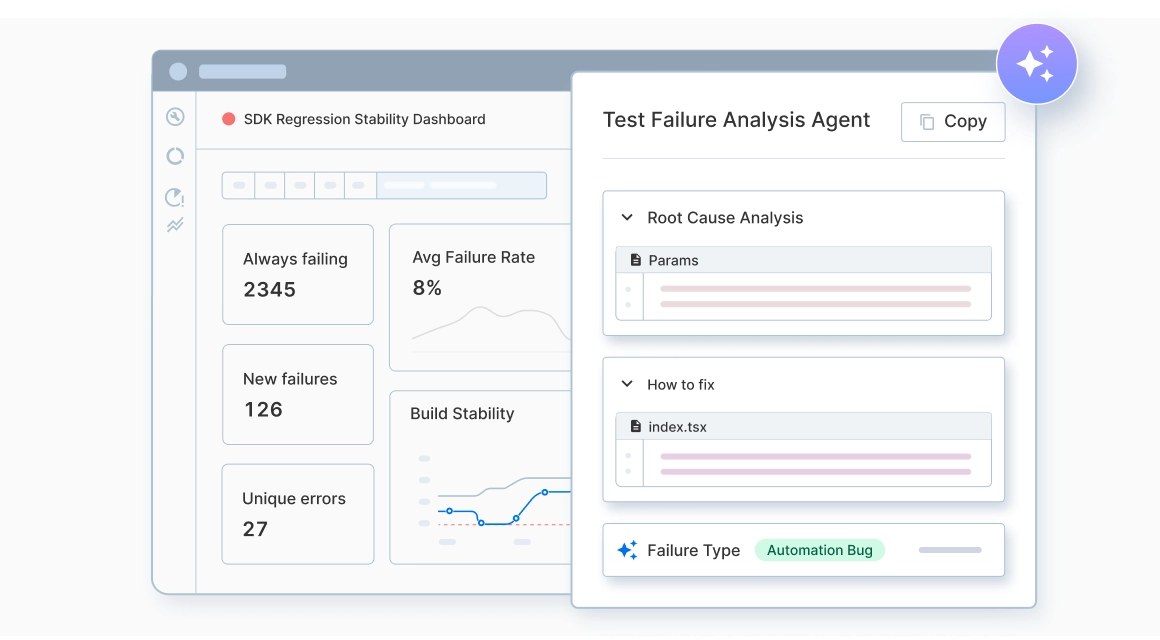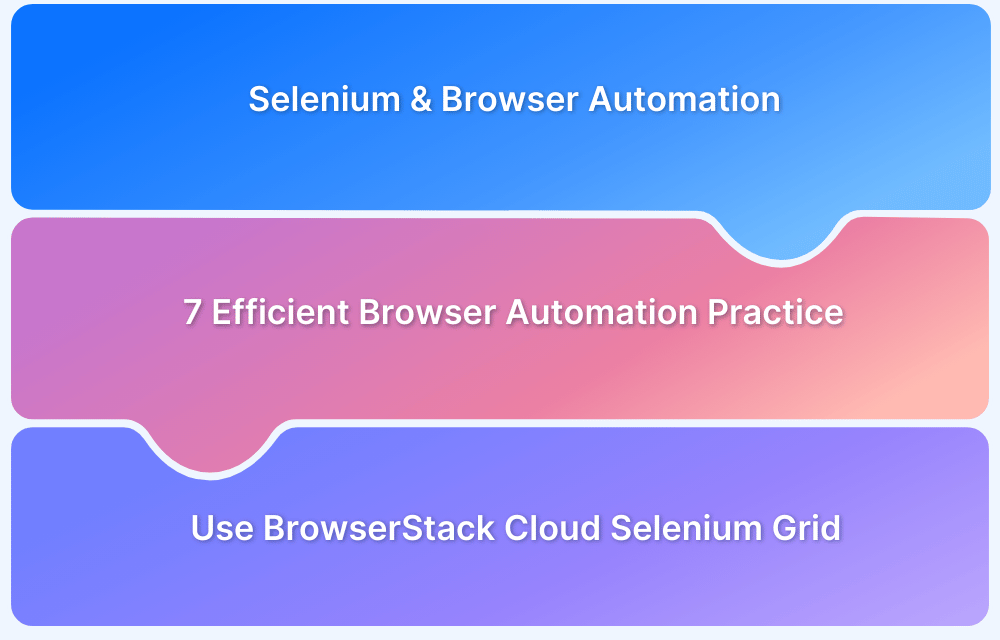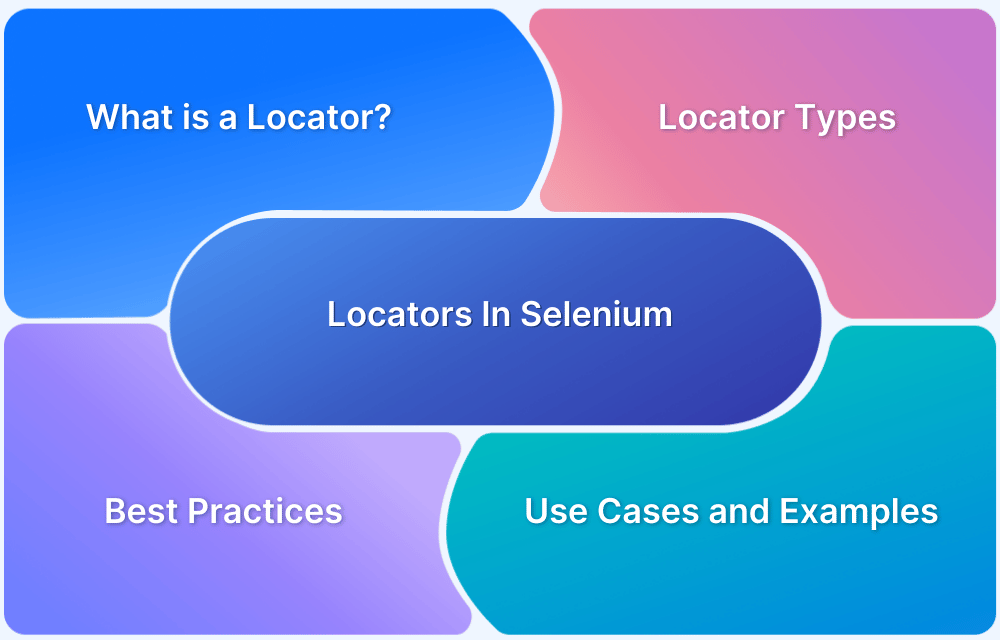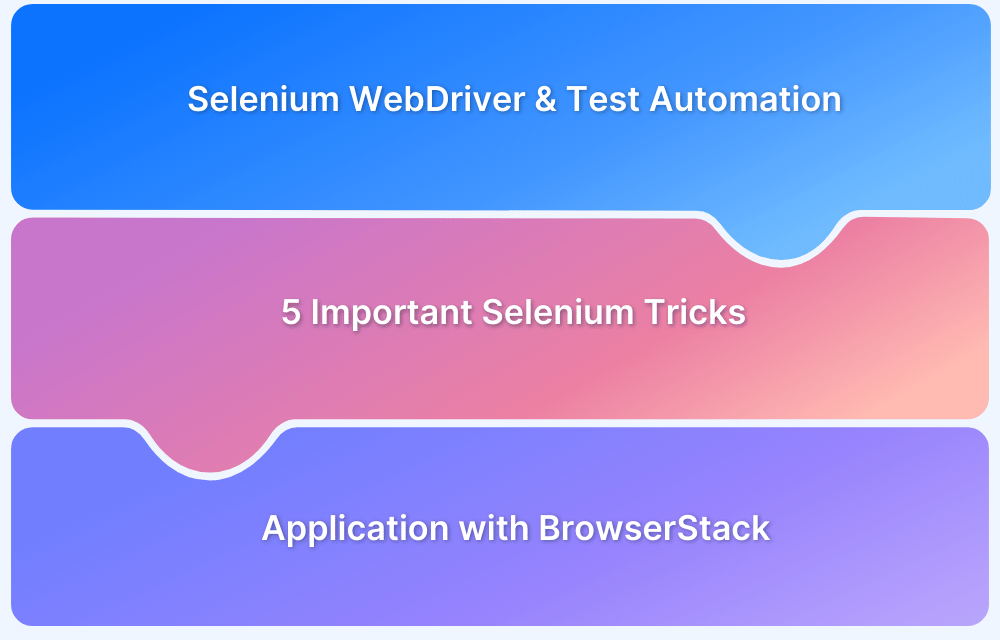Most testers assume Selenium waits for a page to fully load before continuing. I thought the same until a simple shopping cart test kept failing right before a major release.
My script clicked “Add to Cart”, but Selenium often couldn’t locate the updated button—even though it appeared perfectly in screenshots. I tried new selectors, added delays, switched browsers; nothing worked.
That’s when I realized the real issue: Selenium doesn’t automatically wait for dynamic content to finish loading. Without proper waits, tests move ahead of the page.
Understanding how Selenium waits function, and using the right one at the right time is what finally made my tests stable and predictable.
Overview
Selenium waits are mechanisms that pause script execution until a page or element is fully ready for interaction. They help prevent flakiness by ensuring Selenium doesn’t act before the UI has finished loading or updating.
Types of Waits in Selenium (with Examples)
- Implicit Wait: A global wait that tells Selenium to retry finding elements for a set duration.
Example
driver.manage().timeouts().implicitlyWait(Duration.ofSeconds(10));
- Explicit Wait: Waits for a specific condition, like visibility or clickability, before proceeding.
Example
WebDriverWait wait = new WebDriverWait(driver, Duration.ofSeconds(10));
wait.until(ExpectedConditions.visibilityOfElementLocated(By.id("checkout")));- Fluent Wait: Similar to explicit waits but with custom polling intervals and exception handling.
Example
Wait<WebDriver> wait = new FluentWait<>(driver) .withTimeout(Duration.ofSeconds(20)) .pollingEvery(Duration.ofSeconds(2)) .ignoring(NoSuchElementException.class); wait.until(driver1 -> driver1.findElement(By.id("checkout")));
Choosing the Right Wait Strategy
- Use Implicit Wait for simple tests with consistent element availability.
- Use Explicit Wait when waiting for specific conditions like visibility, clickability, or text presence.
- Use Fluent Wait for dynamic, unpredictable DOM changes or slow-loading elements.
- Avoid mixing implicit and explicit waits to prevent unpredictable delays.
- Prefer explicit waits for modern JS-heavy applications (React, Angular, Vue).
This article explores how Selenium waits work, when to use each type, and how they help create more stable and reliable test scripts.
Importance of Page Load in Selenium
A page load is the process of a web page being fetched from the server and fully rendered in the browser. This includes HTML, CSS, JavaScript, and all related resources like images and fonts. Here is why page load is important in Selenium:
- Page loads ensure the availability of elements before interaction, thus preventing test failures.
- It ensures synchronization between test steps and application behavior.
- Proper handling of page loads help spot performance issues like slow or incomplete page loads.
- It improves test reliability while working with dynamic or Ajax-loaded content.
- Reflects real user behavior
Testing page-load behavior becomes even more critical when applications behave differently across browsers, devices, and network conditions.
With Platforms like BrowserStack Automate, you can validate page load performance and element readiness on real browsers and real devices, ensuring your Selenium waits work reliably under true user conditions.
How to implement Selenium wait for page to load
Selenium wait commands tell WebDriver to pause execution until the page or specific elements are ready for interaction. This ensures that elements have enough time to load, become visible, or turn clickable before Selenium attempts any action.
Using waits is essential because without them, Selenium may fail to locate elements and throw errors like Element Not Visible or No Such Element.
Proper wait strategies help prevent these issues by allowing the script to proceed only when the expected conditions are met.
Read More: Exception Handling in Selenium WebDriver
There are three ways to implement Selenium wait for page to load:
- Using Implicit Wait
- Using Explicit Wait
- Using Fluent Wait
Using Implicit Wait
The Implicit Wait tells WebDriver to wait a specific amount of time (say, 30 seconds) before proceeding with the next step. If the tester knows how much time the page and element will take to load, they should use Implicit Wait.
Let’s say a website under test takes ten seconds to load a page until a particular element shows up. In that case, set implicit wait for 10 seconds. The test will pause, and once the time passes, Webdriver will continue to run the script as planned.
WebDriver driver => new FirefoxDriver();
driver.manage().timeouts().implicitlyWait(10, TimeUnit.SECONDS);
driver.get("https://url_that_delays_loading");
WebElement myDynamicElement = driver.findElement(By.id("myDynamicElement"));Note that the Implicit Wait function will be applicable as long as the current browser is open. That means all elements being searched for by the Selenium script will take the time laid out in the Implicit Wait.
Using Explicit Wait
The Explicit Wait is more advanced in its functioning. It instructs WebDriver to pause a test until a predetermined condition is fulfilled.
Let’s say the website under test has a feature displaying a pop-up. The user has to enter some data, following which a pop-up appears. This feature needs to be tested in this exact sequence, including the time taken for the user to input data, server response time, etc.
In this case, the Explicit Wait will wait for the pop-up to appear before proceeding with the test. However, since the test cannot wait an infinite amount of time, testers also insert a duration for WebDriver to pause before carrying on.
from selenium import webdriver
from selenium.webdriver.common.by import By
from selenium.webdriver.support.ui import WebDriverWait
from selenium.webdriver.support import expected_conditions as EC
driver = webdriver.Firefox()
driver.get("http://www.example.com") #This is a dummy website URL
try:
elem = WebDriverWait(driver, 30).until(
EC.presence_of_element_located((By.ID, "Element_to_be_found")) #This is a dummy element
)
finally:
driver.quit()The code will instruct WebDriver to wait for 30 seconds. If the specified condition is met before that, the test will proceed, If not, it will wait the whole 30 seconds before moving forward.
In order to declare an explicit wait, one has to use “ExpectedConditions”. The following Expected Conditions in Selenium can be used in Explicit Wait:
- alertIsPresent()
- elementSelectionStateToBe()
- elementToBeClickable()
- elementToBeSelected()
- frameToBeAvaliableAndSwitchToIt()
- invisibilityOfTheElementLocated()
- invisibilityOfElementWithText()
- presenceOfAllElementsLocatedBy()
- presenceOfElementLocated()
- textToBePresentInElement()
- textToBePresentInElementLocated()
- textToBePresentInElementValue()
- titleIs()
- titleContains()
- visibilityOf()
- visibilityOfAllElements()
- visibilityOfAllElementsLocatedBy()
- visibilityOfElementLocated()
Using Fluent Wait
The Fluent Wait is an advancement on the Explicit Wait. Using it, testers can define a specific condition and the frequency for which WebDriver should check for the condition to appear in a particular length of time.
Let’s say the website under test includes some elements that load dynamically. The tester knows it takes a total of 5 seconds to load, not more. But it can become visible anytime between zero to five seconds.
In this case, Fluent Wait comes to the rescue. The tester can use it to instruct Selenium WebDriver to keep checking on the element at regular intervals.
//Declare and initialise a fluent wait FluentWait wait = new FluentWait(driver); //Specify the timout of the wait wait.withTimeout(5000, TimeUnit.MILLISECONDS); //Specify polling time wait.pollingEvery(250, TimeUnit.MILLISECONDS); //Specify what exceptions to ignore wait.ignoring(NoSuchElementException.class) //This is how we specify the condition to wait on. wait.until(ExpectedConditions.alertIsPresent());
Fluent Wait operates with two main parameters: timeout value and polling frequency. The code defines timeout value as 5 seconds and polling frequency as 0.25 seconds. That means WebDriver will wait no more than 5 seconds to verify the specified condition. If the condition occurs (the element populates) during 5 seconds, it will move on to the next step in the test script. If not, it will return “ElementNotVisibleException”.
Read More: How to start with Selenium Debugging
Handling Asynchronous Page Loads
Web applications can load content asynchronously using JavaScript or Ajax. This implies that parts of the page may proceed to load or update after the initial DOM load is done. Selenium WebDriver does not automatically wait for these asynchronous events, that could lead tests to fail if elements don’t fully load or are visible.
You can manage such cases by:
- Using Explicit Waits to wait for specific conditions (e.g., element visibility, clickability).
- Waiting for Ajax calls to be done by checking for indicators such as loading spinners or particular DOM changes.
- Avoiding the use of fixed delays (Thread.sleep()) as they are unreliable and can slow down tests.
QA teams should strategically leverage Wait commands to ensure the scripts interact with the page only when it’s actually ready.
Common Challenges with Page Load and Selenium
Here are the challenges of page load and Selenium and the corresponding solutions:
1. Interacting with elements before they load
Solution: Use Explicit Waits like visibilityOfElementLocated
2. Handling dynamic/Ajax content
Solution: Wait for specific conditions or DOM changes
3. Test failures because of inconsistent load times
Solution: Execute Fluent Waits with timeout and polling frequency
4. Overuse of Thread.sleep() resulting in slow, flaky tests
Solution: Replace with smart waits (Implicit or Explicit)
These challenges often become even harder to diagnose when tests behave differently across browsers, devices, or environments. To ensure your waits work consistently under real-user conditions, running tests on real browsers is essential.
This is where BrowserStack Automate helps you validate page load behavior reliably and at scale.
Enhance Your Selenium Testing Workflow with BrowserStack
Even with the right wait strategies in place, Selenium tests can behave differently across browsers, devices, and operating systems.
Variations in page load speed, rendering, JavaScript execution, or network conditions often surface issues that local testing can’t replicate. To ensure your waits and page-load logic work reliably under real-user conditions, you need to validate your tests across the environments your users rely on.
BrowserStack Automate helps you do exactly that by running your Selenium tests on a cloud of 3500+ real browsers and device combinations, eliminating the need for local setups or in-house device labs. With Automate, you can:
- Test on real browsers and devices to catch page-load issues caused by actual rendering and real network behavior.
- Run tests in parallel across multiple browser–OS combinations to speed up execution and increase coverage.
- Debug faster using video recordings, screenshots, console logs, and network logs that reveal where waits or conditions failed.
- Integrate seamlessly with CI/CD pipelines like Jenkins, GitHub Actions, GitLab, Azure DevOps, CircleCI, and more.
- Ensure consistent test behavior by running in standardized and reliable real-device environments.
By combining Selenium’s wait mechanisms with BrowserStack’s real-browser testing, you can eliminate flakiness, improve stability, and confidently validate how your application loads across every user environment.
Conclusion
Using Selenium Wait for page to load is quite necessary for automated Selenium testing since it is a common occurrence in everyday internet users’ browsing journey. Selenium Wait commands are exceptionally effective in doing so, and implementing them is fairly uncomplicated, making Browser Automation seamless, as the examples above have demonstrated.
Selenium Waits help detect and debug issues that may occur due to variations in time lag. However, for the results of these commands to be 100% accurate all the time, they must be run on real browsers and devices.
BrowserStack’s cloud Selenium grid offers 3500+ real devices and browsers for automated testing. That means users can run tests on multiple real devices and browsers by simply signing up, logging in, and selecting the required combinations.
Useful Resources for Selenium
Methods, Classes, and Commands
- Selenium Commands every Developer or Tester must know
- Selenium WebElement Commands
- Desired Capabilities in Selenium Webdriver
- Assert and Verify Methods in Selenium
- Understanding System setProperty in Selenium
- Select Class in Selenium : How to select a value in dropdown list?
- SendKeys in Selenium WebDriver
- getAttribute() method in Selenium: What, Why, and How to use
- How does Selenium isDisplayed() method work?
- findElement vs findElements in Selenium
- Types of Listeners in Selenium (with Code Examples)
- How to set Proxy in Firefox using Selenium WebDriver?
Configuration
- How to set up Selenium on Visual Studio
- How to configure Selenium in Eclipse
- Maven Dependency Management with Selenium
- How to Build and Execute Selenium Projects
XPath
- How to use XPath in Selenium?
- How to find element by XPath in Selenium with Example
- Top Chrome Extensions to find Xpath in Selenium
Locators and Selectors
- Locators in Selenium: A Detailed Guide
- CSS Selector in Selenium: Locate Elements with Examples
- How to Create Object Repository in Selenium
Waits in Selenium
- Wait Commands in Selenium C and C#
- Selenium Wait Commands: Implicit, Explicit, and Fluent Wait
- Understanding Selenium Timeouts
- Understanding ExpectedConditions in Selenium
- Understanding Role of Thread.sleep() in Selenium
Frameworks in Selenium
- Data Driven Framework in Selenium
- Implementing a Keyword Driven Framework for Selenium: A Practical Guide
- Hybrid Framework in Selenium
Miscellaneous
- How to create Selenium test cases
- How to set Proxy in Selenium?
- Difference between Selenium Standalone server and Selenium server
- Exception Handling in Selenium WebDriver
- How to use JavascriptExecutor in Selenium
- How to run your first Selenium test script
- Parallel Testing with Selenium
Best Practices, Tips and Tricks
- Top 5 Challenges Faced During Automation Selenium Testing
- 5 Selenium tricks to make your life easier
- 6 Things to avoid when writing Selenium Test Scripts
- Best Practices for Selenium Test Automation
- Why you should pay attention to flaky Selenium tests
- How to start with Selenium Debugging
- How to make your Selenium test cases run faster
- How to upgrade from Selenium 3 to Selenium 4
- Why you should move your testing to a Selenium Cloud?
Design Patterns in Selenium: Page Object Model and Page Factory
- Design Patterns in Selenium
- Page Object Model and Page Factory in Selenium
- Page Object Model and Page Factory in Selenium C#
- Page Object Model in Selenium and JavaScript
- Page Object Model and Page Factory in Selenium Python
Action Class
- How to handle Action class in Selenium
- How to perform Mouse Hover Action in Selenium
- Understanding Click Command in Selenium
- How to perform Double Click in Selenium?
- How to Drag and Drop in Selenium?
- How to Scroll Down or Up using Selenium Webdriver
- How To verify Tooltip Using Selenium
TestNG and Selenium
- Database Testing using Selenium and TestNG
- How to use DataProvider in Selenium and TestNG?
- All about TestNG Listeners in Selenium
- How to run parallel test cases in TestNG
- How to use TestNG Reporter Log in Selenium: Tutorial
- Prioritizing tests in TestNG with Selenium
JUnit and Selenium
- Understanding JUnit assertions for Selenium Testing with Examples
- How to run JUnit Parameterized Test in Selenium
- How to write JUnit test cases
- JUnit Testing Tutorial: JUnit in Java
- How to create JUnit Test Suite? (with Examples)
Use Cases
- Handling Login Popups in Selenium WebDriver and Java
- How to Launch Browser in Selenium
- How to handle Alerts and Popups in Selenium?
- How to get Selenium to wait for a page to load
- How to Find Element by Text in Selenium: Tutorial
- How to Read/Write Excel Data using Apache POI Selenium
- How to handle Captcha in Selenium
- How to handle multiple windows in Selenium?
- How to handle Multiple Tabs in Selenium
- How to find broken links in Selenium
- How to handle Cookies in Selenium WebDriver
- How to handle iFrame in Selenium
- How to handle Web Tables in Selenium
- How To Validate Text in PDF Files Using Selenium Automation
- Get Current URL in Selenium using Python: Tutorial
Types of Testing with Selenium
- Different Testing Levels supported by Selenium
- How to perform UI Testing with Selenium
- Regression Testing with Selenium: Tutorial
- UI Automation using Python and Selenium: Tutorial
- How to Run Visual Tests with Selenium: Tutorial
- How to perform ETL Automation using Selenium
- Cross Browser Testing in Selenium : Tutorial






